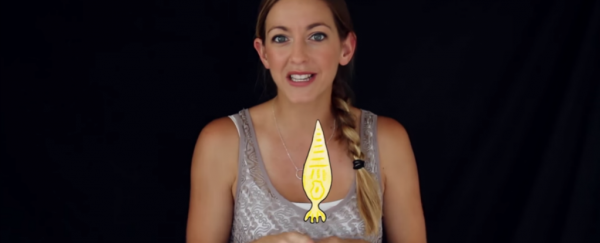
By now, we've all experienced those optical illusions that occur when you stare at a point in the middle of an animated circle and gradually start to see things in the periphery that aren't really there. How do we know they're not there? Look at them directly, and they'll instantly vanish. So why do our eyes and brains convince us that we're seeing things, seemingly for no reason at all? In the latest episode of Physics Girl, we learn that it's actually a really neat trick that allows us to perceive an array of colours, even without the right wavelengths of light being present. Our computer and smartphone screens wouldn't be the same without it.
We start off with a little experiment - if you mix green and red paint, what colour do you get? Well, it's the same answer as when you mix all three primary colours - red, blue, and yellow - together. You get an ugly, muddy brown colour.
When Physics Girl uses the same green and red paint to make a colour wheel, you'd expect that when she spins it, the colours will 'mix' and you'll perceive the same shade of brown. Except that's not the case at all. In the video, you can clearly see that by spinning the colour wheel, she makes bright yellow.
So what's going on here? It's actually very simple, colours of paint don't mix the same way as colours of light. When she spins her red and green colour wheel, there's no yellow light being reflected off it into your eyes. Instead, your brain is being tricked into perceiving yellow because of the way the different components of your eyes work together.
On your retina, you've got three types of cone cells that can only perceive one type of colour each - red light, blue light, and green light. And together these three cones allow us to see every colour imaginable, from orange and bright yellow to deep magenta and purple. So when your eyes are hit with yellow light, your red and green cone cells respond in varying degrees, and when this combination is sent to your brain, it identifies the particular colour as yellow.
This also works when your eyes are hit with both a red light and a green light - the cones respond, and the brain interprets the combination as yellow, even if there's zero yellow light to be perceived. "This is how your LCD screen tricks you into seeing yellow," says Physics Girl in the video above.
Now what about if you take the brightest red you can find, and the brightest cyan, and you mix them together. What do you get? No colour at all seems like the most counter-intuitive answer you could come up with, except when you remember that all colours combined make white light. So why does it work with just red and cyan? Watch the latest episode of Physics Girl above to see for yourself, and get ready for some seriously cool optical illusions.
Thanks for being such an awesome sport, brain. We owe you one.
